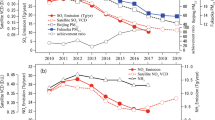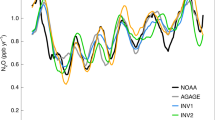Abstract
Swift changes in both industrialization and pollution control in China over the past 15 years have created a complex and evolving relationship between emission sources and the depositional sinks of air pollutants. Here, by combining an emissions inventory, an air quality model and a statistical model to estimate bulk deposition (wet plus a part of dry), we present the changes and driving factors of source–sink relationships of typical pollutants throughout China between 2005 and 2020. We find that the deposition of sulfate and nitrate has declined more slowly than the emissions of their precursors, sulfur dioxide and nitrogen oxides, which we attribute, in part, to increased precipitation. In four developed regions of China, enhanced air pollution transport also plays an important role in the slower decline of deposition compared with that of emissions, as has a changing aerosol chemistry in the case of sulfur compounds. Our analysis shows that reducing deposition is not as simple as merely reducing its precursor emissions and suggests that the design of future policies to reduce associated risks may need to vary by region and species, accounting for their evolving interactions over time.
This is a preview of subscription content, access via your institution
Access options
Access Nature and 54 other Nature Portfolio journals
Get Nature+, our best-value online-access subscription
$29.99 / 30 days
cancel any time
Subscribe to this journal
Receive 12 print issues and online access
$259.00 per year
only $21.58 per issue
Buy this article
- Purchase on Springer Link
- Instant access to full article PDF
Prices may be subject to local taxes which are calculated during checkout




Similar content being viewed by others
Data availability
Source data are provided with this paper.
Code availability
The code used to develop the GAM model for deposition estimation is available at https://figshare.com/s/975d70e28612f96e64b2.
References
Zheng, B. et al. Trends in China’s anthropogenic emissions since 2010 as the consequence of clean air actions. Atmos. Chem. Phys. 18, 14095–14111 (2018).
Crippa, M. et al. Gridded emissions of air pollutants for the period 1970–2012 within EDGAR v4.3.2. Earth Syst. Sci. Data 10, 1987–2013 (2018).
Stevens, C. J. et al. Impact of nitrogen deposition on the species richness of grasslands. Science 303, 1876–1879 (2004).
Bowman, W. D. et al. Negative impact of nitrogen deposition on soil buffering capacity. Nat. Geosci. 1, 767–770 (2008).
Liu, X. J. et al. Enhanced nitrogen deposition over China. Nature 494, 459–462 (2013).
Yu, G. R. et al. Stabilization of atmospheric nitrogen deposition in China over the past decade. Nat. Geosci. 12, 424–429 (2019).
Xia, Y. M., Zhao, Y. & Nielsen, C. P. Benefits of China’s efforts in gaseous pollutant control indicated by the bottom-up emissions and satellite observations 2000–2014. Atmos. Environ. 136, 43–53 (2016).
Krotkov, N. A. et al. Aura OMI observations of regional SO2 and NO2 pollution changes from 2005 to 2015. Atmos. Chem. Phys. 16, 4605–4629 (2016).
Flower, D. et al. Nonlinearities in source receptor relationships for sulfur and nitrogen compounds. Ambio 34, 41–46 (2005).
Zhang, X. Y. et al. Decadal trends in wet sulfur deposition in China estimated from OMI SO2 columns. J. Geophys. Res. Atmos. 123, 10796–10811 (2018).
Wesely, M. L. & Hicks, B. B. A review of the current status of knowledge on dry deposition. Atmos. Environ. 34, 2261–2282 (2000).
Wen, Z. et al. Changes of nitrogen deposition in China from 1980 to 2018. Environ. Int. 144, 106022 (2020).
Zhou, K. et al. Declining dry deposition of NO2 and SO2 with diverse spatiotemporal patterns in China from 2013 to 2018. Atmos. Environ. 262, 118655 (2021).
Liu, M. et al. Rapid SO2 emission reductions significantly increase tropospheric ammonia concentrations over the North China Plain. Atmos. Chem. Phys. 18, 17933–17943 (2018).
Li, H. Y. et al. Rapid transition in winter aerosol composition in Beijing from 2014 to 2017: response to clean air actions. Atmos. Chem. Phys. 19, 11485–11499 (2019).
Wang, G. H. et al. Persistent sulfate formation from London fog to Chinese haze. Proc. Natl Acad. Sci. USA 113, 13630–13635 (2016).
Xing, J. et al. Nonlinear response of ozone to precursor emission changes in China: a modeling study using response surface methodology. Atmos. Chem. Phys. 11, 5027–5044 (2011).
Li, M. et al. Persistent growth of anthropogenic non-methane volatile organic compound (NMVOC) emissions in China during 1990–2017: drivers, speciation and ozone formation potential. Atmos. Chem. Phys. 19, 8897–8913 (2019).
Jin, X. & Holloway, T. Spatial and temporal variability of ozone sensitivity over China observed from the Ozone Monitoring Instrument. J. Geophys. Res. Atmos. 120, 7229–7246 (2015).
Wang, S. X. et al. Impact assessment of ammonia emissions on inorganic aerosols in East China using response surface modeling technique. Environ. Sci. Technol. 21, 9293–9300 (2011).
Yu, T. et al. Long-term trends in acid neutralizing capacity under increasing acidic deposition: a special example of eutrophic Taihu Lake, China. Environ. Sci. Technol. 50, 12660–12668 (2016).
Zhang, Q. et al. Satellite remote sensing of changes in NOx emissions over China during 1996-2010. Chin. Sci. Bull. 57, 2857–2864 (2012).
Xu, W. et al. Quantifying atmospheric nitrogen deposition through a nationwide monitoring network across China. Atmos. Chem. Phys. 15, 12345–12360 (2015).
Xu, W. et al. A database of atmospheric nitrogen concentration and deposition from the nationwide monitoring network in China. Sci. Data 6, 51 (2019).
Zhao, Y., Zhang, J. & Nielsen, P. The effects of recent control policies on trends in emissions of anthropogenic atmospheric pollutants and CO2 in China. Atmos. Chem. Phys. 13, 487–508 (2013).
Xu, Y. Improvements in the operation of SO2 scrubbers in China’s coal power plants. Environ. Sci. Technol. 45, 380–385 (2011).
Kurokawa, J. et al. Emissions of air pollutants and greenhouse gases over Asian regions during 2000–2008: Regional Emission inventory in ASia (REAS) version 2. Atmos. Chem. Phys. 13, 11019–11058 (2013).
Kurokawa, J. & Ohara, T. Long-term historical trends in air pollutant emissions in Asia: Regional Emission inventory in ASia (REAS) version 3. Atmos. Chem. Phys. 20, 12761–12793 (2020).
Klimont, Z. et al. Global anthropogenic emissions of particulate matter including black carbon. Atmos. Chem. Phys. 17, 8681–8723 (2017).
Kang, Y. et al. High-resolution ammonia emissions inventories in China from 1980 to 2012. Atmos. Chem. Phys. 16, 2043–2058 (2016).
Chen, Y. et al. Interannual variation of reactive nitrogen emissions and their impacts on PM2.5 air pollution in China during 2005–2015. Environ. Res. Lett. 16, 125004 (2021).
Ding, J. Y. et al. Intercomparison of NOx emission inventories over East Asia. Atmos. Chem. Phys. 17, 10125–10141 (2017).
Itahashi, S. et al. Inverse estimation of NOx emissions over China and India 2005–2016: contrasting recent trends and future perspectives. Environ. Res. Lett. 14, 124020 (2019).
Koukouli, M. E. et al. Updated SO2 emission estimates over China using OMI/Aura observations. Atmos. Meas. Tech. 11, 1817–1832 (2018).
Li, C. et al. India is overtaking China as the world’s largest emitter of anthropogenic sulfur dioxide. Sci. Rep. 7, 14304 (2017).
Miyazaki, K. et al. Decadal changes in global surface NOx emissions from multi-constituent satellite data assimilation. Atmos. Chem. Phys. 17, 807–837 (2017).
Qu, Z. et al. Monthly top-down NOx emissions for China (2005–2012): a hybrid inversion method and trend analysis. J. Geophys. Res. Atmos. 122, 4600–4625 (2017).
Qu, Z. et al. SO2 emission estimates using OMI SO2 retrievals for 2005–2017. J. Geophys. Res. Atmos. 124, 8336–8359 (2019).
Qu, Z. et al. Hybrid mass balance/4D-Var joint inversion of NOx and SO2 emissions in East Asia. J. Geophys. Res. Atmos. 124, 8203–8224 (2019).
Hastie, T. J. & Tibshirani, R. J. Generalized Additive Models (Chapman & Hall, 1990).
Simon, N. W. Generalized Additive Models: An Introduction with R 2nd edn (Chapman & Hall/CRC, 2006).
Johnson, J. W. A heuristic method for estimating the relative weight of predictor variables in multiple regression. Multivariate Behav. Res. 35, 1–19 (2000).
Budescu, D. V. Dominance analysis: a new approach to the problem of relative importance of predictors in multiple regression. Psychol. Bull. 114, 542–551 (1993).
Ge, B. Z. et al. Model inter-comparison study for Asia (MICS-Asia) phase III: multimodel comparison of reactive nitrogen deposition over China. Atmos. Chem. Phys. 20, 10587–10610 (2020).
Itahashi, S. et al. MICS-Asia III: overview of model intercomparison and evaluation of acid deposition over Asia. Atmos. Chem. Phys. 20, 2667–2693 (2020).
Xing, J. et al. Development and application of observable response indicators for design of an effective ozone and fine-particle pollution control strategy in China. Atmos. Chem. Phys. 19, 13627–13646 (2019).
Pan, Y. P. et al. Identifying ammonia hotspots in China using a national observation network. Environ. Sci. Technol. 52, 3926–3934 (2018).
Pan, Y. P. et al. Wet and dry deposition of atmospheric nitrogen at ten sites in northern China. Atmos. Chem. Phys. 12, 6515–6535 (2012).
EANET Data on the Acid Deposition in the East Asian Region (Network Center for EANET, accessed 28 January 2022); https://monitoring.eanet.asia/document/public/index
Liu, M. Y. et al. Improved aerosol correction for OMI tropospheric NO2 retrieval over East Asia: constraint from CALIOP aerosol vertical profile. Atmos. Meas. Tech. 12, 1–21 (2019).
Krotkov, N. A. et al. OMI/Aura Sulfur Dioxide (SO2) Total Column L3 1 Day Best Pixel in 0.25° × 0.25° V3 (Goddard Earth Sciences Data and Information Services Center, 2015).
Li, C. et al. A fast and sensitive new satellite SO2 retrieval algorithm based on principal component analysis: application to the ozone monitoring instrument. Geophys. Res. Lett. 40, 6314–6318 (2013).
Damme, M. V. et al. Version 2 of the IASI NH3 neural network retrieval algorithm: near-real-time and reanalysed datasets. Atmos. Meas. Tech. 10, 4905–4914 (2017).
Johnson, S. J. et al. SEAS5: the new ECMWF seasonal forecast system. Geosci. Model Dev. 12, 1087–1117 (2019).
Ma, Z. W. et al. Estimating ground-level PM2.5 in China using satellite remote sensing. Environ. Sci. Technol. 48, 7436–7444 (2014).
Acknowledgements
This work was sponsored by the National Key Research and Development Program of China (2017YFC0210106 to Y.Z., W.X., X.L. and Y.P.) and the Natural Science Foundation of China (41922052 to Y.Z. and 42177080 to Y.Z., M.M. and K.Z.).
Author information
Authors and Affiliations
Contributions
Y.Z. designed the research. Y.Z., M.X. and Z.D. performed the research. Q.Z. and B.Z. processed the emissions data. W.X., Z.W., X.L. and Y.P. provided observational deposition data. M.M., K.Z., J.X., C.P.N., Y.L. and L.Z. interpreted the data. Y.Z., M.X. and C.P.N. wrote the paper with input from all the co-authors.
Corresponding author
Ethics declarations
Competing interests
The authors declare no competing interests.
Peer review
Peer review information
Nature Geoscience thanks Stefan Reis and Thorjorn Larssen for their contribution to the peer review of this work. Primary Handling Editors: Simon Harold and Xujia Jiang, in collaboration with the Nature Geoscience team.
Additional information
Publisher’s note Springer Nature remains neutral with regard to jurisdictional claims in published maps and institutional affiliations.
Extended data
Extended Data Fig. 1 The spatial patterns of average annual deposition of SO42−, NO3−, and NH4+ over China.
The left, central and right column indicate the average for 2005-2009 (2008-2009 for NH4+), 2010–2014, and 2015–2020, respectively. The horizontal resolution is 0.25o(lat)×0.25o(lon).
Supplementary information
Supplementary Information
Supplementary Figs. 1–16 and Tables 1–9.
Source data
Source Data Fig. 1
Interannual change in emission and deposition for China.
Source Data Fig. 2
Gridded data of D/E for different species and periods.
Source Data Fig. 3
Interannual change in D/E for different species and regions.
Source Data Fig. 4
Relative differences of SNA/E between scenarios for different species and region simulated with Air Quality RSM.
Source Data Extended Data Fig. 1
Gridded data of bulk deposition for different species and periods.
Rights and permissions
About this article
Cite this article
Zhao, Y., Xi, M., Zhang, Q. et al. Decline in bulk deposition of air pollutants in China lags behind reductions in emissions. Nat. Geosci. 15, 190–195 (2022). https://doi.org/10.1038/s41561-022-00899-1
Received:
Accepted:
Published:
Issue Date:
DOI: https://doi.org/10.1038/s41561-022-00899-1
This article is cited by
-
Recent Progress in Atmospheric Chemistry Research in China: Establishing a Theoretical Framework for the “Air Pollution Complex”
Advances in Atmospheric Sciences (2023)



